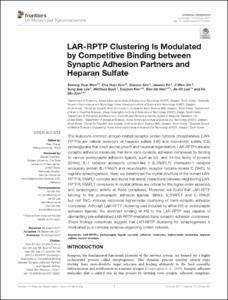LAR-RPTP Clustering Is Modulated by Competitive Binding between Synaptic Adhesion Partners and Heparan Sulfate
- Title
- LAR-RPTP Clustering Is Modulated by Competitive Binding between Synaptic Adhesion Partners and Heparan Sulfate
- Author(s)
- Won, Seoung Youn ; Kim, Cha Yeon ; Kim, Doyoun ; Ko, Jaewon ; Um, Ji Won ; Lee, Sung Bae ; Buck, Matthias ; Kim, Eunjoon ; Heo, Won Do ; Lee, Jie-Oh ; Kim, Ho Min
- DGIST Authors
- Won, Seoung Youn ; Kim, Cha Yeon ; Kim, Doyoun ; Ko, Jaewon ; Um, Ji Won ; Lee, Sung Bae ; Buck, Matthias ; Kim, Eunjoon ; Heo, Won Do ; Lee, Jie-Oh ; Kim, Ho Min
- Issued Date
- 2017-10
- Type
- Article
- Article Type
- Article
- Author Keywords
- LAR-RPTPs ; postsynaptic ligand ; synaptic adhesion molecules ; higher-order clustering ; heparan sulfate ; crystal structure
- Keywords
- DEPENDENT TRANSSYNAPTIC ADHESION ; PROTEIN-TYROSINE-PHOSPHATASES ; MIDLINE AXON GUIDANCE ; PTP-SIGMA ; STRUCTURAL BASIS ; RECEPTOR ; COMPLEX ; PROTEOGLYCANS ; ARCHITECTURE ; MOLECULE
- ISSN
- 1662-5099
- Abstract
- The leukocyte common antigen-related receptor protein tyrosine phosphatases (LAR-RPTPs) are cellular receptors of heparan sulfate (HS) and chondroitin sulfate (CS) proteoglycans that direct axonal growth and neuronal regeneration. LAR-RPTPs are also synaptic adhesion molecules that form trans-synaptic adhesion complexes by binding to various postsynaptic adhesion ligands, such as Slit- and Trk-like family of proteins (Slitrks), IL-1 receptor accessory protein-like 1 (IL1RAPL1), interleukin-1 receptor accessory protein (IL-1RAcP) and neurotrophin receptor tyrosine kinase C (TrkC), to regulate synaptogenesis. Here, we determined the crystal structure of the human LAR-RPTP/IL1RAPL1 complex and found that lateral interactions between neighboring LAR-RPTP/IL1RAPL1 complexes in crystal lattices are critical for the higher-order assembly and synaptogenic activity of these complexes. Moreover, we found that LAR-RPTP binding to the postsynaptic adhesion ligands, Slitrk3, IL1RAPL1 and IL-1RAcP, but not TrkC, induces reciprocal higher-order clustering of trans-synaptic adhesion complexes. Although LAR-RPTP clustering was induced by either HS or postsynaptic adhesion ligands, the dominant binding of HS to the LAR-RPTP was capable of dismantling pre-established LAR-RPTP-mediated trans-synaptic adhesion complexes. These findings collectively suggest that LAR-RPTP clustering for synaptogenesis is modulated by a complex synapse-organizing protein network. © 2017 Won, Kim, Kim, Ko, Um, Lee, Buck, Kim, Heo, Lee and Kim.
- Publisher
- Frontiers Media S.A.
- Related Researcher
-
-
Ko, Jaewon
- Research Interests Synapse Formation and Function; Neural Circuits; 뇌질환; animal model
-
- Files in This Item:
-
 기타 데이터 / 5.54 MB / Adobe PDF
download
기타 데이터 / 5.54 MB / Adobe PDF
download



